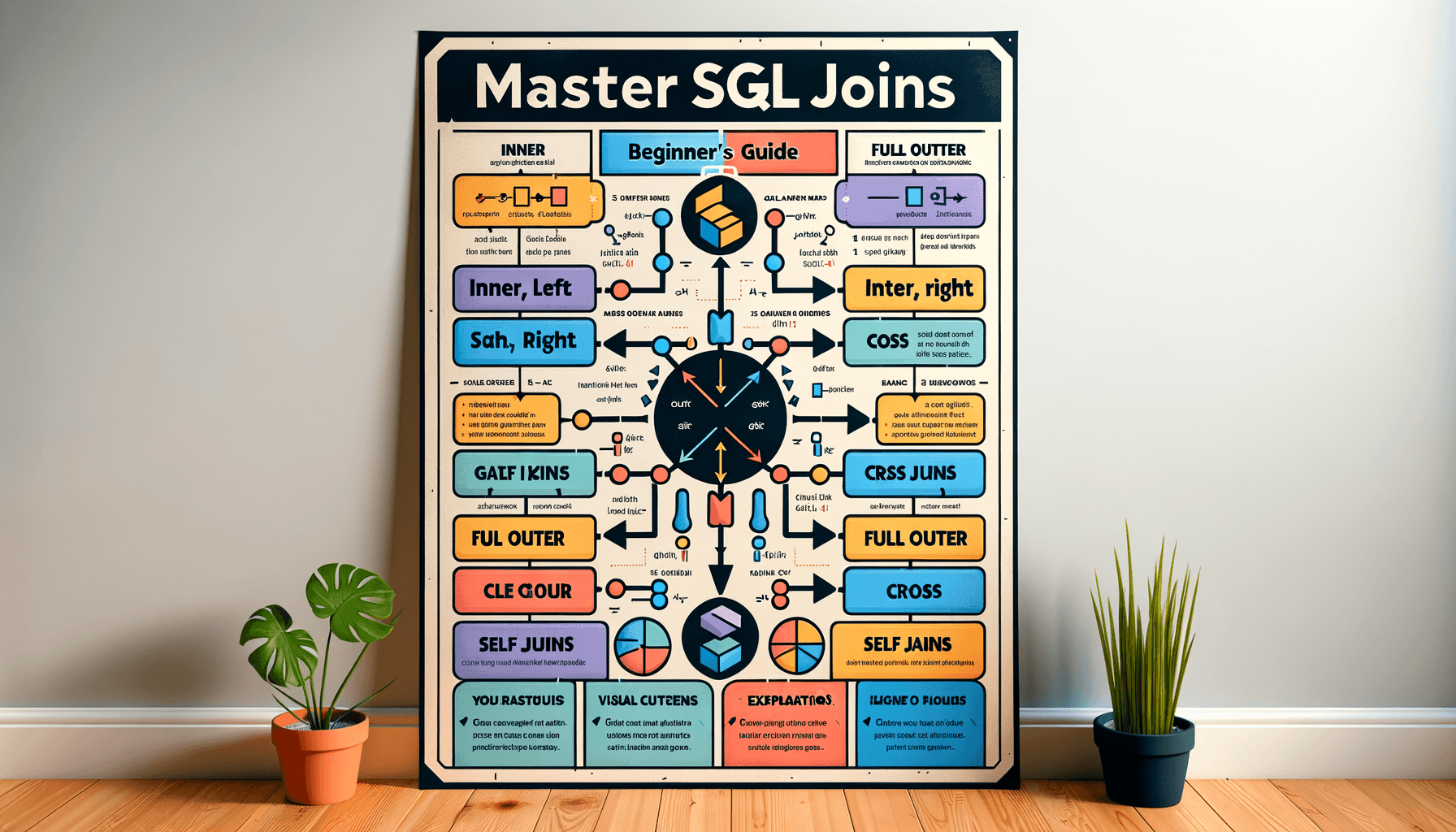A big variety of articles and resources

Mastering Data Relationships: Learn SQL Joins for Beginners
 Sia Author and Instructor
Learn SQL
Sia Author and Instructor
Learn SQL
10 minute read
Understanding SQL Joins
SQL Joins act as the magic glue that sticks our data together. They offer speed, clarity, and flexibility, making it easier for us to make sense of our information, connect the dots, and get a full view of what’s happening in our databases.
Inner Joins: Combining Data Effectively
Inner Joins are fundamental in SQL for merging data from two or more tables based on a related column. They return only the rows where there is a match in both tables, making them essential for precise data analysis.
How Inner Joins Work
Inner Joins work by comparing each row of the first table with each row of the second table to find all pairs of rows that satisfy the join condition. This join condition is typically based on a primary key and foreign key relationship.
Examples of Inner Joins
Consider two tables: Employees and Departments. To find employees and their respective departments, you can use an Inner Join:
SELECT Employees.name, Departments.department_name FROM Employees INNER JOIN Departments ON Employees.department_id = Departments.id;
This query will return only those employees who are assigned to a department.
Common Use Cases
- Filtering data to include only related records from multiple tables.
- Performing data analysis where only matched records are relevant.
- Simplifying complex queries by focusing on interconnected data points.
Inner Joins are a powerful tool for database professionals, enabling them to navigate intricate relationships between tables effectively.
For more advanced techniques, consider exploring our [mini course: sql joins explained](pathname: /course/mini-course-sql-joins-explained).
Left and Right Joins: Exploring Differences
When delving into the world of SQL joins, understanding the nuances of left and right joins is essential. These join types enable you to retrieve data from multiple tables in distinct ways. A left join retrieves all records from the left table and the matched records from the right table, while a right join does the opposite, retrieving all records from the right table and the matched records from the left table. Mastering the application of left and right joins empowers you to manipulate and combine data effectively, providing a comprehensive view of interconnected data points.
Left Joins Explained
In scenarios where inclusivity is key, employing a LEFT JOIN offers a broader perspective on data consolidation. With a LEFT JOIN, all rows from the left table are retained in conjunction with matched rows from other tables. This approach allows for unmatched records from one or more tables to be included in the result set, providing a comprehensive view of interconnected data points.
Right Joins Explained
Conversely, a RIGHT JOIN retrieves all records from the right table and the matched records from the left table. This method is particularly useful when the primary focus is on the right table's data, ensuring no information is lost from that table while still incorporating relevant matches from the left table.
When to Use Left or Right Joins
Choosing between a left or right join depends on the specific requirements of your query. If you need to ensure all data from the left table is included, regardless of matches, a left join is appropriate. On the other hand, if the right table's data is paramount, a right join is the better choice. Understanding these distinctions allows for more strategic data manipulation and retrieval.
Mastering Full Outer Joins
How Full Outer Joins Work
In the realm of SQL joins, the full outer join is a powerful tool for combining data from multiple tables. This join type retrieves all records from both tables, matching them where possible and filling in nulls for unmatched records. Mastering the technique of full outer joins expands your ability to retrieve comprehensive data sets, including matched and unmatched records from the joined tables.
Examples of Full Outer Joins
Consider two tables, Employees and Departments. A full outer join between these tables will return all employees and all departments, matching them where possible. If an employee is not assigned to a department, the department fields will be null, and vice versa.
SELECT Employees.Name, Departments.DepartmentName FROM Employees FULL OUTER JOIN Departments ON Employees.DepartmentID = Departments.DepartmentID;
Advantages and Disadvantages
Advantages:
- Comprehensive data retrieval: Retrieves all records from both tables, providing a complete dataset.
- Useful for data analysis: Helps in identifying unmatched records, which can be crucial for data integrity checks.
Disadvantages:
- Performance overhead: Full outer joins can be resource-intensive, especially with large datasets.
- Complexity: The resulting dataset can be complex to interpret, especially with many null values.
By understanding and effectively utilizing full outer joins, you can elevate your SQL skills and gain a deeper understanding of relational databases.
Cross Joins: Unleashing Their Potential
Understanding Cross Joins
In the world of SQL, the cross join is a potent tool for combining every row from one table with every row from another. This unfettered pairing of data sets can be a powerful asset when used judiciously. However, it’s essential to approach cross joins with caution, as they have the potential to generate an excessively large result set if not handled carefully.
Examples of Cross Joins
Effectively, cross joins can be a valuable asset in scenarios such as Cartesian product calculations or when creating a combination of all possible pairs of items from two or more sets. Understanding the potential and pitfalls of cross joins is integral to mastering SQL joins and expanding your data querying capabilities.
Use Cases and Considerations
By delving into the intricacies of this join type, you can enhance your SQL skills and wield the power of cross joins with precision and proficiency. Cross joins can be particularly useful in scenarios where you need to generate comprehensive pairings of data, such as in a data analyst - introduction to SQL course offers hands-on SQL training with industry insights. Instructor Eric Vanier specializes in database performance and optimization.
When leveraged effectively, cross joins can be a valuable asset in scenarios such as Cartesian product calculations or when creating a combination of all possible pairs of items from two or more sets.
Self Joins: Joining a Table to Itself
Self joins in SQL involve joining a table to itself. This technique proves valuable in scenarios where you need to compare rows within the same table. By creating a self join, you can effectively retrieve related data points and gain insights from the internal relationships within the table. Mastering the concept of self joins expands your SQL proficiency, allowing you to uncover valuable connections and patterns within your data.
Self-joins are a unique type of join where a table is joined with itself. This can be particularly useful for hierarchical or sequential data. For example, if you have a table of employees with a column indicating their managers, who are also employees, you can use a self-join to pair employees with their managers.
SELECT e1.name AS Employee, e2.name AS Manager FROM employees e1 JOIN employees e2 ON e1.manager_id = e2.employee_id;
A Self Join becomes intriguing when dealing with a scenario involving a social network where users can connect and form friendships. In this context, a Self Join can be used to discover mutual friendships between users within the same table. This unique scenario demonstrates the versatility of Self Joins in exploring connections within the same entity, providing a valuable tool for diverse data structures.
Understanding the application of self joins is essential for any SQL practitioner looking to master SQL basics for beginners at your own pace. No credit card required. Login or sign up to start learning with SQLSkillz.
Enhancing SQL Skills with Joins
Best Practices for Using Joins
To maximize the efficiency of your SQL queries, it's essential to follow best practices when using joins. Always ensure that you are joining on indexed columns to speed up the query execution. Additionally, be mindful of the join order, as it can significantly impact performance.
Optimizing Join Performance
Optimizing join performance involves several strategies, such as using appropriate join types for your specific use case and minimizing the number of columns in the SELECT statement. Another effective technique is to use subqueries or temporary tables to break down complex joins into simpler, more manageable parts.
Common Pitfalls to Avoid
When working with joins, it's crucial to avoid common pitfalls like joining on non-indexed columns or using unnecessary joins that can slow down your queries. Be cautious of Cartesian products, which can occur when using cross joins without proper filtering.
By exploring the intricacies of SQL joins, you can significantly enhance your data retrieval and manipulation capabilities.
For more detailed tutorials and examples, websites like [sqlskillz.com](https://sqlskillz.com) and w3schools.com offer comprehensive guides to help you master SQL joins at your own pace.
Enhancing your SQL skills with joins can significantly boost your data management capabilities. Our comprehensive courses are designed to help you master complex SQL joins, making your data queries more efficient and effective. Don't miss out on the opportunity to advance your technical knowledge and career prospects. Visit our website to explore our course catalogue and get started today!
Conclusion
Mastering SQL joins is a fundamental skill for anyone working with relational databases. By understanding and applying different types of joins—such as inner joins, left and right joins, full outer joins, cross joins, and self joins—you can efficiently combine data from multiple tables to extract meaningful insights. This guide has provided you with the essential knowledge and practical examples to navigate SQL joins with confidence. As you continue to practice and apply these concepts, you'll enhance your data querying capabilities and unlock the full potential of your data. Keep experimenting, stay curious, and happy querying!
Frequently Asked Questions
What are SQL Joins and why are they important?
SQL Joins allow you to combine data from multiple tables in a relational database. They are important because they enable you to retrieve and manipulate data across different tables, providing a comprehensive view of the data.
What are the different types of SQL Joins?
The different types of SQL Joins include Inner Join, Left Join, Right Join, Full Outer Join, Cross Join, and Self Join. Each type serves a specific purpose in combining data from tables.
How does an Inner Join work?
An Inner Join returns records that have matching values in both tables. It combines rows from both tables as long as there is a match between the columns being joined.
When should I use a Left Join or a Right Join?
Use a Left Join when you want to retrieve all records from the left table and the matched records from the right table. Use a Right Join when you want to retrieve all records from the right table and the matched records from the left table.
What is a Full Outer Join and when should I use it?
A Full Outer Join returns all records when there is a match in either left or right table records. It is useful when you need to retrieve all records from both tables, regardless of whether they have matching records.
What are some best practices for using SQL Joins?
Some best practices for using SQL Joins include keeping queries simple, understanding your data relationships, conducting performance tests, and avoiding common pitfalls such as not properly indexing tables or using unnecessary joins.
Related Articles

Mastering Data Management: Learn SQL Language Today
9 minute read

Top Places to Learn SQL: A Comprehensive Guide
10 minute read



